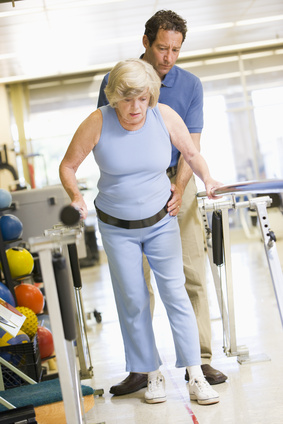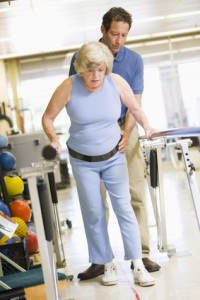Post-Stroke Rehabilitation with Physical Therapy
In the United States more than 700,000 people suffer a stroke each year. Approximately 2/3 of these individuals survive the cerebral vascular accident and require rehabilitation (relearn skills that are lost when part of the brain is damaged). The goals of rehabilitation are to help survivors become as independent as possible and to attain the best possible quality of life.
Physical therapists specialize in treating disabilities related to motor and sensory impairments. They are trained in all aspects of anatomy and physiology related to normal function, with an emphasis on movement. They assess the patient’s strength, endurance, range of motion, gait abnormalities and sensory deficits to design individualized rehabilitation programs aimed at regaining control over motor functions.
impairments. They are trained in all aspects of anatomy and physiology related to normal function, with an emphasis on movement. They assess the patient’s strength, endurance, range of motion, gait abnormalities and sensory deficits to design individualized rehabilitation programs aimed at regaining control over motor functions.
Functions compromised when a specific region of the brain is damaged by stroke can sometimes be taken over by other parts of the brain. This ability to adapt and change is known as neuroplasticity. Physical therapists help the patient regain the use of stroke-impaired limbs, teach compensatory strategies to reduce the effect of remaining deficits and establish ongoing exercise programs to help people retain their newly learned skills. The repetitive use of impaired limbs encourages brain plasticity!
In general, physical therapy emphasizes practicing isolated movements, repeatedly changing from one kind of movement to another and rehearsing complex movements that require a great deal of coordination and balance. Balance retraining may consist of walking up or down stairs or moving safely between obstacles. People too weak to bear their own weight can still practice repetitive movements during hydrotherapy (water providing a sensory stimulation and allowing for weight support) or while being partially supported by a harness. A recent trend in physical therapy emphasizes the effectiveness of engaging in goal-directed activities, such as playing games, to promote coordination, balance and movement strategies.
If you or your loved one has had a stroke, be sure to be evaluated by a physical therapist as they can substantially help people achieve the best possible long-term outcome.

 People with minor motor system disorders to severe disorders will find that physical therapy can help with the rigidity, slow movement patterns, postural instability, impaired balance and coordination that seem to evolve along with this disease. The physical therapist will evaluate for Functional Gait Testing, Functional Reach Testing, Timed Get Up and Go Test, Bed mobility screening and orthopedic evaluations for mobility and strength.
People with minor motor system disorders to severe disorders will find that physical therapy can help with the rigidity, slow movement patterns, postural instability, impaired balance and coordination that seem to evolve along with this disease. The physical therapist will evaluate for Functional Gait Testing, Functional Reach Testing, Timed Get Up and Go Test, Bed mobility screening and orthopedic evaluations for mobility and strength. A physical therapy evaluation and treatment strategy will assist in specific exercises for the weakness that develops by using functional manual skills that stimulate the central nervous system at the time of the movement pattern. They will work with gait training to evaluate for any equipment you may need for comfort and safety. They have been trained in detailed vestibular rehabilitation for balance and coordination issues that may come up during those fluctuating periods of exacerbation.
A physical therapy evaluation and treatment strategy will assist in specific exercises for the weakness that develops by using functional manual skills that stimulate the central nervous system at the time of the movement pattern. They will work with gait training to evaluate for any equipment you may need for comfort and safety. They have been trained in detailed vestibular rehabilitation for balance and coordination issues that may come up during those fluctuating periods of exacerbation.